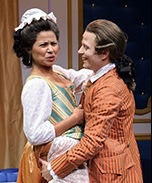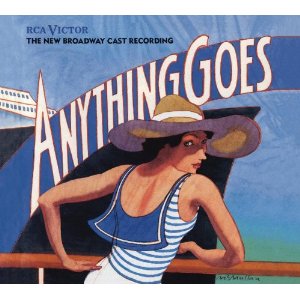SITE GUIDE
SEARCH
REVIEWS
REVIEW ARCHIVES
ADVERTISING AT CURTAINUP
FEATURES
NEWS
Etcetera and
Short Term Listings
LISTINGS
Broadway
Off-Broadway
NYC Restaurants
BOOKS and CDs
OTHER PLACES
Berkshires
London
California
New Jersey
DC
Philadelphia
Elsewhere
QUOTES
TKTS
PLAYWRIGHTS' ALBUMS
LETTERS TO EDITOR
FILM
LINKS
MISCELLANEOUS
Free Updates
Masthead
A CurtainUp Review
Figaro
|
"So I read every thing I could lay my hands on. And I watched the rich whenever I could. I studied their manners, how they spoke, how they walked; how they carried their perfect heads in that way that makes everyone understand immediately who is in charge.<"/i>— Figaro
|

Jolly Abraham and Sean McNall
(Photo: Jacob J. Goldberg) |
Beaumarchais’ initial play about Figaro, The Barber of Seville, first performed in1775, at the Comédie-Française in the Tuileries, was based on commedia dell’arte themes and characters. It recounts how Figaro helps the Count woo and win Rosine, who is locked up in the house of her guardian, Dr, Bartholo.
Three years later, Beaumarchais returned to Figaro. By this time, the Count has grown tired of Rosine, and his womanizing has thrown her into despair (and the arms of the Count’s page, Cherubin). Figaro is about to marry Suzanne, the Countess’s maid, but when Suzanne tells him she has become the object of the Count’s unwanted attention, he goes into action.
Figaro concocts a scheme, which might have worked if not for alternative schemes by the Countess; the aging housekeeper, Marceline, who is determined to marry Figaro herself; and Cherubin, who is in love with being in love.
Given the play’s scorching comments on the shenanigans of the nobility, it should not come as a surprise that Louis XVI initially banned the play. Nor should it surprise that the play proved so popular when read clandestinely that Louis was forced to relent. The Marriage of Figaro was a hit among the nobility, which enjoyed laughing at itself, and the working class, which enjoyed laughing at the nobility.
Today Figaro is a French icon, celebrated every time someone picks up the newspaper, Le Figaro. We also might well recall Figaro every time we see people of the lower classes outwitting their “betters.”
The Pearl’s staging uses period costumes and set. And although Morey has updated much of the language and filled the dialogue with modern references, such as Nixon’s Checker’s Speech and Oscar Wilde’s The Importance of Being Earnest, his version is basically true to the original. Yet The Marriage of Figaro is decidedly relevant today, given the political climate we live in.
Under Hal Brooks’ superb direction, the show does not move; it flies. Laugh follows laugh as quickly as galloping horses. Sean McNall is an enthusiastic Figaro who can also be thoughtful. His ironic asides to the audience are seamlessly integrated into the dialogue and never seem forced. MacNall overflows with self-confidence and energy. One could not ask for a better Figaro.
Figaro finds his perfect match and mate in Suzanne, as played by Jolly Abraham. She is every inch a modern woman in servants’ clothing. She is far more wise than ridiculous, though she never ceases to be funny.de Joey Parsons as the Countess and Chris Mixon as the Count, as well as Robin Leslie Brown as Marceline and Ben Charles, who plays Cherubin.
The Marriage of Figaro is a most enjoyable experience. But let us not forget it preceded the French Revolution by only eleven years. Laughter can be dangerous.
|
Figaro Adapted by Charles Morey, from Pierre Beaumarchais’ The Marriage of Figaro. Directed by Hal Brooks Cast: Sean McNall (Figaro), Jolly Abraham (Suzanne), Dan Daily (Doctor Bartholo), Robin Leslie Brown (Madeline). Ben Charles (Cherubin/Doublemain) Chris Mixon (Count Almaviva), Bradd Herberlee (Bazile/Antonio/Bridoison), Joey Parsons (Countess Almaviva), Tiffany Vilarin (Franchette) Scenic Designer: Jo Winiarski Costume Designer: Barbara A. Bell Lighting Designer: Stephen Petrilli Sound Designer: Jane Shaw Stage Manager: Dale Smallwood Running time: 2 hours with one intermission Pearl Theater, Peter Sharp Theater 555 West 42nd Street (212) 563-9261 pearltheatre.org From 10/19/12; opening 11/04/12 closing 12/02/12 Tuesday at 7pm, Wednesday at 2pm and 8pm, Thursday and Friday at 8pm, Saturday at 2pm and 8pm, Sunday at 2pm Tickets: $60, $35 seniors, $20 students, $20 Thursday rush Reviewed by Paulanne Simmons Nov. 9, 2012 |
|
REVIEW FEEDBACK Highlight one of the responses below and click "copy" or"CTRL+C"
Paste the highlighted text into the subject line (CTRL+ V): Feel free to add detailed comments in the body of the email. . .also the names and emails of any friends to whom you'd like us to forward a copy of this review. Visit Curtainup's Blog Annex For a feed to reviews and features as they are posted add http://curtainupnewlinks.blogspot.com to your reader Curtainup at Facebook . . . Curtainup at Twitter Subscribe to our FREE email updates: E-mail: esommer@curtainup.comesommer@curtainup.com put SUBSCRIBE CURTAINUP EMAIL UPDATE in the subject line and your full name and email address in the body of the message. If you can spare a minute, tell us how you came to CurtainUp and from what part of the country. |

Slings & Arrows- view 1st episode free
 Anything Goes Cast Recording
Anything Goes Cast RecordingOur review of the show
 Book of Mormon -CD
Book of Mormon -CDOur review of the show

